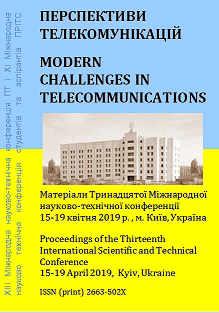ТОЧНОСТЬ ОЦЕНКИ КООРДИНАТ АППАРАТУРЫ ПОТРЕБИТЕЛЯ ПРИ ИСПОЛЬЗОВАНИИ ПРОСТРАНСТВЕННОГО СИГНАЛА ОДНОГО КОСМИЧЕСКОГО АППАРАТА
Ключові слова:
пространственно-временной сигнал, навигационный спутник, точность, координатыАнотація
Precise Estimation of Mobile Ground Station
Coordinates from a Single Satellite Signal
Spatial wave front estimation of signals emitted by global navigation satellite systems (GNSS) may provide accurate geo – positioning even when only one or two satellites are located in the receiver’s field of view. The paper studies the maximum achievable precision of the coordinate estimation by a navigation receiver based on statistical methods used in radiolocation.
Оценки параметров фазового фронта пространственно-временного сигнала космического аппарата (КА) спутниковой навигационной системы могут сделать возможным решение навигационной задачи по сигналам только одного или двух КА. В работе исследуется предельно достижимая точность оценки координат аппаратуры потребителя (АП) на основе статистических методов, применяемых в радиолокации, в условиях, когда в области видимости АП находится один КА.
Посилання
Шарко В. П. Методика определения навигационных параметров движущихся объектов по волновому фронту сигналов радионавигационных систем: дис. на соискание науч. степени канд. техн. наук / Шарко Вадим Павлович. – Киев, 2012. – 150 с.
Соловьёв Ю. А. Системы спутниковой навигации. – М.: Эко-Трендз, 2000. – 267 с.
Ширман Я.Д., Манжос В.Н. Теория и техника обработки радиолокационной информации на фоне помех. – М.: Радио и связь, 1981. – 416 с.
Ивченко Г.И., Медведев Ю.И. Введение в математическую статистику: Учебник. – М.: Издательство ЛКИ, 2010, - 600 с.
##submission.downloads##
Як цитувати
Номер
Розділ
Ліцензія
Авторське право (c) 2019 Вадим Павлович Шарко, Анатолій Важевич Цулая

Ця робота ліцензується відповідно до Creative Commons Attribution 4.0 International License.
Authors who submit to this conference agree to the following terms:a) Authors retain copyright over their work, while allowing the conference to place this unpublished work under a Creative Commons Attribution License, which allows others to freely access, use, and share the work, with an acknowledgement of the work's authorship and its initial presentation at this conference.
b) Authors are able to waive the terms of the CC license and enter into separate, additional contractual arrangements for the non-exclusive distribution and subsequent publication of this work (e.g., publish a revised version in a journal, post it to an institutional repository or publish it in a book), with an acknowledgement of its initial presentation at this conference.
c) In addition, authors are encouraged to post and share their work online (e.g., in institutional repositories or on their website) at any point before and after the conference.

